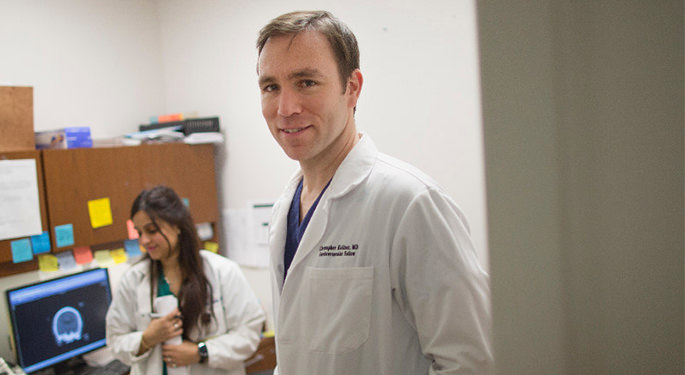
Subarachnoid Hemorrhage
Subarachnoid hemorrhage occurs when a blood vessel ruptures at the base of the brain. Blood fills up the subarachnoid space, an area between the brain and the thin tissues that cover it. Mount Sinai cerebrovascular specialists are expert at evaluating and treating this condition.
Causes for subarachnoid hemorrhage include brain aneurysms, arteriovenous malformations (AVM), amyloid angiopathy, and head trauma. The most common symptom is having a very severe headache that starts suddenly and is often located near the back of the head. Even if you are prone to headaches or migraines, this headache will feel very different from the normal pattern. Most patients describe it as the "worst headache of my life."
Diagnosis
Based on your symptoms, we may perform an eye exam, computed tomography, lumbar puncture spinal tap, cerebral angiography, and/or a transcranial Doppler ultrasound.
Treatment Options
We treat subarachnoid hemorrhage by one or more of the following strategies:
- Endovascular coiling of brain aneurysms blocks blood flow into the aneurysm to prevent rupture.
- Mini-craniotomy (surgical removal of part of the bone from the skull to expose the brain) and clip ligation of brain aneurysms blocks the aneurysm from circulating in the body.
- Endovascular embolization of the AVM uses a special glue to block abnormal blood vessels.
- Radiosurgery of the AVM involves delivering radiation directly to the hemorrhage.
- Surgical resection of the AVM separates the hemorrhage from the blood flow.
- Minimally invasive “burr hole” removal of intracerebral hemorrhage can be effective.
- Balloon angioplasty expands the blood vessel to ease blood flow.
- Ventriculostomy and ventriculoperitoneal shunt placement can prevent or relieve abnormal buildup of fluid in the brain.
- Craniotomy helps decompress brain edema (the excessive accumulation of fluid in the tissue).